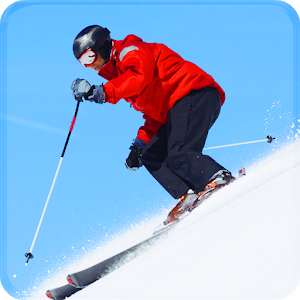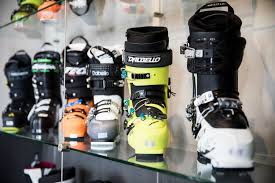Skiing: Put your feet first
- May 12, 2018
-
Jane Earl
- Uncategorized

Having been born and raised in England, my first introduction to skiing was on the dry brush-meshed ski slopes of Gloucester Ski and Snowboard Centre. Protecting your hands from the harsh synthetic surface and keeping your thumbs out of the mesh was drilled into us. I didn’t even think about what was going on inside my ski boots. It wasn’t until a few years later when I began to think about the mechanics of skiing. In those days my interest was driven by my personal goal to ski better. The closest most of my patients had come to skiing was the BBCs coverage of the winter Olympics (always pretty good in my recollection). My professional interest in the mechanical demands of skiing developed later when I started working for ACT Podiatry.
The mechanics of skiing
As with most sports, skiing places some unique demands on the feet. The mechanics of skiing are quite unlike walking or running. The knee is held flexed, ankle flexion is very limited, and turns are initiated by shifting weight from one side of the foot to the other. Effective weight distribution through the feet is a key aspect to performance during Alpine skiing, even at beginner level. Snow ploughers keep the weight on the inside of both skis simultaneously. More advanced parallel skiers shift their weight from one ski to the other, turning the ski inwards or outwards to steer or break. The feet must also absorb high impact forces of jumps and other advanced ski manoeuvres.
Get the right boots
For first time buyers, this is a very exciting time. You have fallen in love with the sport and are making a commitment. You may be investing a lot of money, so it is important to make the right choice. This can be quite difficult given the huge number of makes and boot types on the market today. You really need to seek the advice of an experienced ski boot fitter. And the same is true when hiring equipment.
Consideration should be given to your skiing ability, weight and skiing style. As a general rule, beginners should go for a boot with a softer flex, that is comfortable and warm. The trade-off is that softer boots are harder to control, especially at high speeds. An intermediate level boot should be firmer as these boots are better suited to higher speeds and better turning. If you are a competent skier looking for high performance gear, you should choose a stiff boot. The tighter the fit the more responsive your skis will be. Therefore, trade-off for this level of performance can sometimes be comfort.

Properly fitted boots are essential
Two common pitfalls to be aware of:
1) Purchasing an entry level boot and improving so quickly your boot underperforms.
2) Overestimating your skiing ability. Unless you ski regularly throughout the season, it is unlikely you will be skiing at an advanced level, even though you may be very confident skier. Go for an intermediate level boot which offers enough stiffness for speedy manoeuvring but is not too tight. Few things will spoil your skiing more than boot that is too tight.
Boot liners
Having purchased your ski boots, you may be offered a choice of linings. The three types are non-mouldable, thermomouldable and custom mouldable. Non-mouldable inlays will gradually compress with time to take the form of your foot bed. Thermo-mouldable use your body heat to gradually mould to the contours of you feet after a day or two of wear. Custom mouldable are heated using an external heat source (typically a heat gun) and moulded to your natural contours. In some cases, podiatric assessment for prescription foot othotics will be required.
Poor foot mechanics
So, effective skiing is dependent on your ability to transmit force through the insides of the ski. If your foot mechanics are inefficient turning will be more difficult. Even if you have a high level of general physical fitness, poor lower limb mechanics can cause you to fatigue quickly. This makes injuries are more likely towards the end of the day.
Flat feet- If your feet ‘roll in’ (pronate) excessively, increased knee and pelvic rotation will be required to turn the skis. The same is true for people with knock knees.
Bow legs- Your feet will have a tendency to ‘roll out’, baring more weight on the outer sides. Again, increased effort will be required to shift weight to the inside edge of the ski for turning.
Foot orthotics
Custom foot orthoses can have an almost immediate effect on your skiing ability and endurance. They work by allowing your foot to work about its most efficient position. You should talk to your podiatrist before you head off to the snow to see if your current foot orthotics are appropriate, remembering the mechanics of walking and running are quite different to skiing.
Common Foot Problems
The most obvious thing to think about is the effect of the cold on the feet. And this can be a big problem when skiing in sub zero temperatures. The effect of tight ski boots increases the risk of chilblains and frost bite. Those with pre-existing circulation problems such as Raynaud’s disease and smokers are at greatest risk. Good ski socks made from a moisture wicking material will help keep your feet warm and dry. Read my ‘winter feet’ blog for more advice on keeping your feet warm.
Blisters are a common consequence of poorly fitting ski boots. Take care that they are not loose as this will cause excess heel slippage of sliding of the forefoot. Always take your ski socks with you when having your boots fitted to ensure an optimal fit. Make sure your feet are kept dry as moist feet blister more easily.
Podiatric surgery
Mechanical foot problems associated with skiing include bunions, hammer toes, neuromas and heel pain. Usually these conditions respond well to mechanical correction. However, if you are still worried about squeezing into your ski boots for 7 hours shifts on-piste, it might be time to consider other treatment options. If you have painful bony lumps on your feet, or persistent burning or shooting pain, podiatric surgery might be the solution you are looking for. I would recommend consulting with Dr Clayton Clews, Podiatric Foot and Ankle Surgeon for a detailed assessment and to discuss all your treatment options.
So, if you are worried about any aspect of your foot health you should make an appointment at ACT Podiatry well ahead of your proposed ski trip. Foot pain isn’t something you will want to deal with a day into your ski holiday.
Suite 8 (Ground Floor), 146 Scollay St, Greenway ACT 2900
6287 4889
6293 2325
[email protected]
ACT Podiatry : Advanced Foot & Ankle Centre
Canberra Podiatric Surgeon
Suites 16-17 (First floor) 14-16 Brierly St, Weston ACT 2611
6287 2818
6293 2325
[email protected]
ACT Podiatry : Advanced Foot & Ankle Centre
Canberra Podiatric Surgeon
Copyright © 2018, ACT PODIATRY | SEO by High Jump Digital

